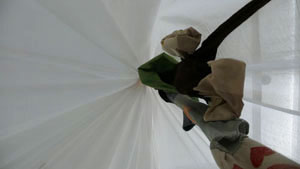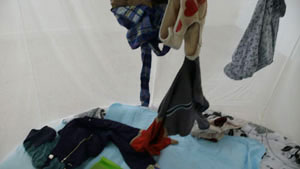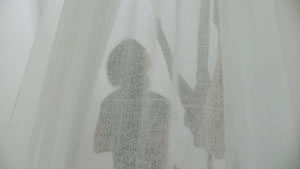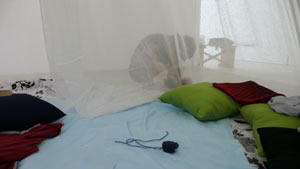



“The present contains nothing more than the past, and what is found in the effect was already in the cause”
Henri Bergson
Eva Michalaki’s visual practice is a personal transcription of time. Michalaki’s works can be seen as the writing of a private version of history, which does not necessarily aim for an objective description of accurate events but rather the creation of a vivid narrative based on experience and strong imagery. Following the tradition of a young girl’s diary she orchestrates total environments based on free association that depict her position in a particular instant. Michalaki’s narration of history deduced by autobiographical elements draws from the basic and universal qualities of a fairy tale rather than those of an epistemic depiction of the past.
In her previous preoccupation with travel journals she has attempted to record the present through first hand observations and a visual reading of her own experiences of dislocation. Michalaki marks her own spacetime continuum by creating a compilation of memories through the fragments of a voyage. Like a contemporary visual Pausanias, she produces books that map a certain autobiogeography composed by phrases, photographs, scraps, sketches and storylines. These hybrid artist’s books are produced in the philosophy of the collage in a manner that betray Michalaki’s fascination for the interspersion of media, typical of the Surrealist tradition, that ultimately flirts with the elimination of the medium borders. The horror vacui composition of these scrapbooks is evidence of the artist’s erratic, almost childlike, fury for creation and of the particular esthesia of time distinct only in the traveler’s haste to absorb the most in a limited duration.
In Le Petit chaperon rouge, the artist transforms her travel journal into a time travel diary. The manifestation of this travel is no longer a book, but a complete installation comprising of three chapters, each of which are experienced like flipping through the pages of one of her travel journals. In this time travel diary, Michalaki explores the fragmented memories of a childhood following the free association method seen in her travel journals. The artist’s choice of title reflects a young girl’s coming of age passage, as seen in the fairy tale. After having left home, little red ridding hood ventures into a series of ominous events that she faces alone. Before coming out of this series of events with the maturity of experience, she is first victimized as a child by the dark forces of which she had not been prepared.
The introductory section of the exhibition welcomes the viewer to enter as a guest, the privacy of the staged memoir. The gauze canopy that protects the installation, creates the sense of the blurry, dreamlike ambiance of a distant memory cut off from reality, but also hints on a traumatic character of an introverted childhood. The pendulous toys and stitched children’s clothing of the mobile skulking over the visitor’s head mirror the trauma of an action suspended midway. The seating of comfortable cushions on the floor and the open invitation to a young girl’s notebooks console the harshness of the mobile and act as a version of a child’s security blanket. The entrance to the next chapter of Le petit Chaperon rouge, is closed off to the viewer. Behind bars and in a completely dark environment, a white nightgown is hung creating the eerie effect of a haunting past that is secured in the darkest corners of memory. The final section of the exhibition acts as the replica of a home. Drawings of household objects are hanging from the wall and two diaries invite the viewer to glimpse into the rules of the host. The delicate materials of the artist’s handmade bookbinding and the intimacy of the thoughts scribbled in the diaries, seem to silently demand the viewer’s caution and care similar to what is expected by a friend invited to the artist’s home.
The naif morale of the fairy tale, the ghostly image of a flowing white nightgown, the unsystematic sequence of drawings on tracing paper notebooks pose as hazy remnants of a past joined only by the artist’s stream of consciousness. The exhibition reads less as a tribute to the loss of childhood and more as a testament to it after having achieved a level of maturity in recording time through the consciousness of personal experience.
By Evita Tsokanta




le petit chaperon rouge @ stoa aeschylou - the arcade project | nicosia.cy
performance | room 01 | room 02 | room 03 | text | | | home